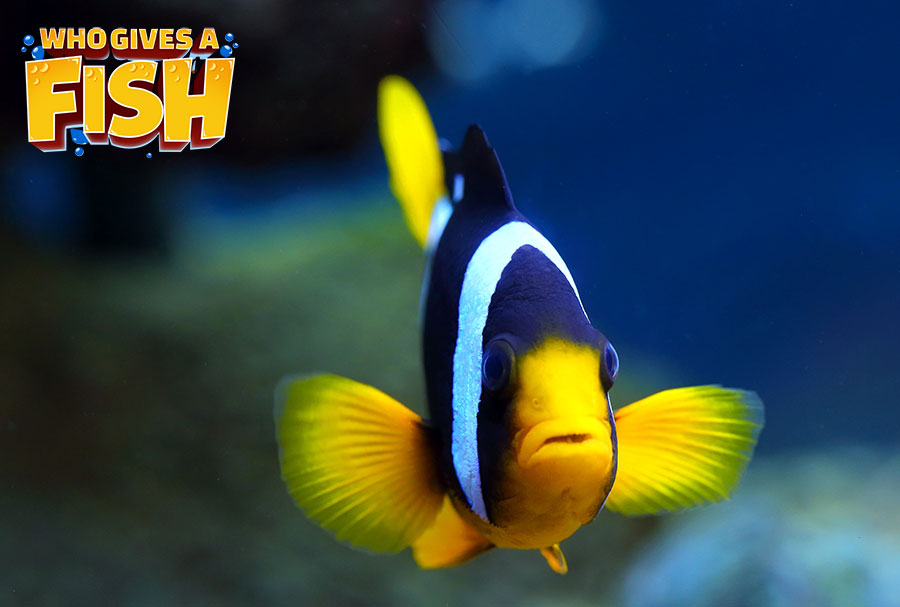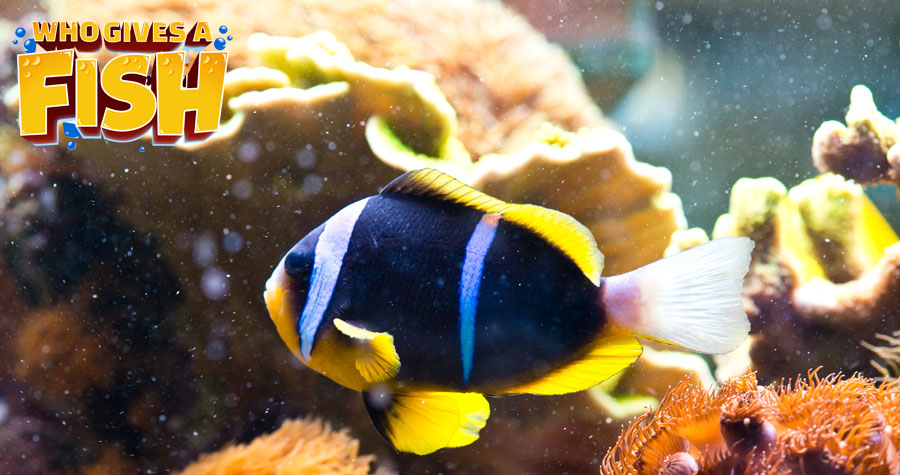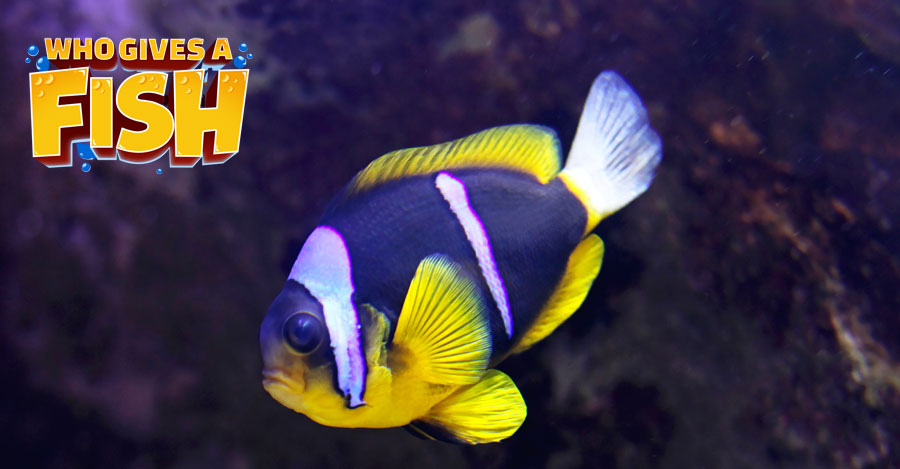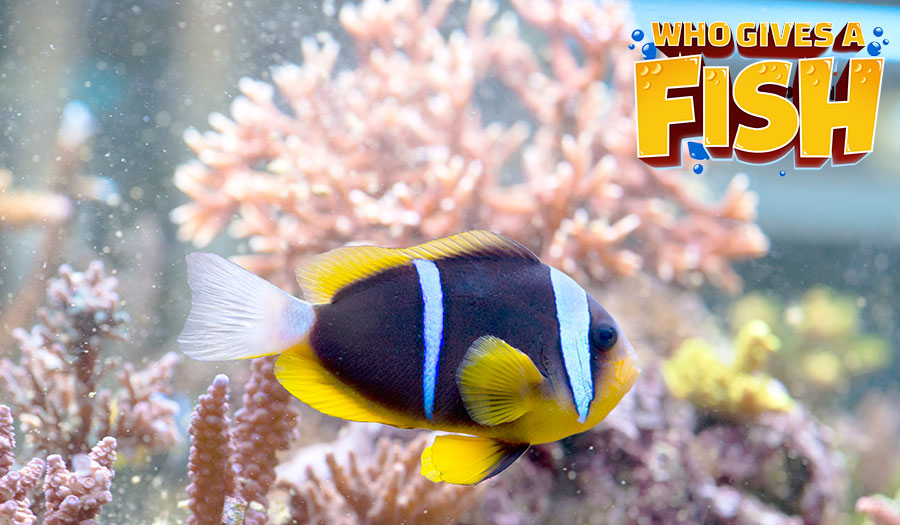Clarkii Clownfish
The Clarkii Clownfish Amphiprion clarkii is a boldly fashioned, rugged fish that makes a fine accessory to almost any saltwater aquarium. It sports a rounded, strong body and is known to reach a length of around 5 1/2 inches (15 cm). Various species can be fairly distinct in color, with adults spanning from brown to yellow. There are two wide white bands on the body, and often a third near the bottom of the tail. The shining nose and tail fin is known to span from a yellow to white color.
- Experience Level: Beginner
- Hardiness: Very Hardy
- Minimum Tank Size: 30 gal (114 L)
- Size of fish: 5.5 inches (14.99 cm)
- Temperament: Semi-aggressive
- Temperature: 74.0 to 82.0° F (23.3 to 27.8° C)
- pH Range: 7.8-8.4
- Diet: Omnivore
Table of Contents
Introduction
Aquarium Setup
Difficulty
Feeding
Breeding and Social
A few of the other more usual names for this fish include the Clark’s Clownfish and the Clark’s Anemonefish along with a host of detailed names such as the Black Clownfish, Yellowtail Clownfish, Brown Anemonefish, Chocolate Clownfish and many more. There are also quite a few stunning types that have been cultivated, displaying lively white blotches on the flanks of the body. Names conceived for these comprise of the Spotted Clarki Clownfish, Picasso Clarki Clownfish and for the latest type, the Galaxy Clarki Clownfish.
Comparable types of clownfish breeds are bunched together in what are referred to as complexes. This fish is the proper name for a crowd of anemonefish in the Clarkii Complex. However, this particular species has some intriguing contrasts. This fish resides in the deepest depths, and has been logged at a depth of 179 feet. Its tail fin is not circular as a few of other clownfish, which bestows it the talent to swim quicker than the other species. It also has a few abnormalities in the breeding domain. All clownfish are indistinguishable when they born but they are known to switch sexes. With particular social cues, they transform into juvenile males, and then one also transforms into a superior female for spawning. Mannerisms for this breed include having two clowns that could both turn female, or may could possibly stay male. In addition, a group of three juveniles reared together may in fact breed in a threesome of one exhausted male with 2 females, rather than a usual coupling.
The Clark’s Clown are maybe one of the most enjoyable and rugged of the clownfish species. Although having notable breeding in captivity, these fish can usually be bought in a couple, but just purchasing two juvenile fish will generally result in a female and male pair in time. The usual varieties are easily available and fairly priced, making them an excellent choice for the amateur, or any marine aquarium devotee. The designer clownfish are also readily found, but are usually expensive.
These anemonefishes are very rugged. Being audacious swimmers, they will spend a majority of their time out in the open. They are extremely simple to house, but will relish a little bit more space than most other clowns owing to their aptitude to swim further. They are less reliant on a host anemone for security than their cousins. When scared in the wild, they will usually choose to hide inside the reef rather than nestling in an overprotective host. Anemonefish are usually referred to as singing fish, as they tend to make popping or chirping noises, with each different breed having its own language. The Clarkii clownfish has also been known to form frequent and louder noises than other anemonefish, and its tunes are even able be detected outside the tank.
Amphiprion-Clarkii
Aquarium Setup
The Clarkii Clownfish is decent sized and a fairly active clown. It requires a tank size of 30 (114 L) minimum for a single specimen, however 40-50 gallons will be ideal, and 55 gallons’ minimum for a couple. Remember that smaller tank sizes result in rapid degradation of water quality, thereby needing 5% water changes every week. Though they are lenient of less than ideal water quality, extended exposure to poor water quality will result in disease and illness with any saltwater fish.
Supply live rock and fashion a few hiding spots if there is no anemone present. Rapid water motion will make it difficult for them to swim, therefore if you have a fish in the tank that requires rapid water motion, supply that near the back of the tank so the Clarkii won’t get blasted around. It is an audacious fish that will swim to the surface to feed when it becomes acclimatized to its home.
This breed exists in tropical regions, so be sure to maintain aquarium water temperatures ranging between 74°F to 82°F (23.3 – 27.8°C), and they are able to tolerate endure a pH range from 7.8 to 8.4. Extreme temperatures over 90° F (32° C) or under 64° F (18° C) would be outside of their comfort zone. Ideal breeding occurs between 79°F to 83°F (26°C to 28°C).
If you are trying to house them with an anemone, the size of the tank should be suitable to the specific anemone’s demands. With an anemone, it will require satisfactory lighting and the tank will need to be well established, implying that it needs to be 6 months to a year old. They will spend most of their time with a host, but will also swim in all areas of the aquarium, so they require some open room for swimming freely.
Clarkii Clownfish Aquarium Guide
- Minimum Tank Size: 30 gal (114 L) – A minimum of 30 gallons is required for a single fish, with 50 gallons plus for a pair being ideal. If keeping with an anemone a larger tank of 55 gallons or more is recommended.
- Suitable for Nano Tank: No. Highly advised against nano-tank
- Live Rock Requirement: Rock structures with ample hiding places are important, especially when there is no anemone present.
- Substrate Type: Any
- Lighting Needs: Any – They have no special lighting requirements though if kept with a host, the anemone will need its appropriate lighting.
- Temperature: 74.0 to 82.0° F (23.3 to 27.8° C)
- Breeding Temperature: 79.0° F – The optimal temperature for good quality eggs and larvae occurs with temperatures of 79° F to 82° F (26° – 28°C).
- Specific gravity: 1.023-1.025 SG
- pH Range: 7.8-8.4
- Brackish: No
- Water Movement: No heavy flow – Provide areas in the tank with calmer waters for general activity and feeding.
- Water Region: All – They prefer open areas, but will hide in rocks and coral when required.
Difficulty
The Clarkii Clownfish are easy to care for and extremely rugged They make excellent fish for the amateur aquarist. These clownfish are extremely simple to keep, just make ensure to get a fish that is eating when purchasing. You can request that the store feed the tank just to make sure. The specimen should also be attentive. Try to avoid any specimens that have any surplus mucus or slime or white casting on their rear. Little white spots on their body is also a forewarning of Crypt, and as such these specimens must be avoided.
Feeding
The Clark’s Clownfish is an omnivore. When in the wild they feed on amphipods, small shrimp, polychaete worms, zoo plankton, benthic algae and weeds, and more. When in the aquarium, they will consume a wide assortment of frozen, live and flake foods. They will also eat algae naturally growing in the tank.
It is imperative that you supply it with an assortment of frozen or fresh meaty foods for a majority of their diet. Ideal foods comprise of shrimp or fish flesh, finely shredded, along with brine shrimp and mysis. Their diet should also contain an assortment of vegetable source foods in flake and pellet form. Make sure to feed 3 to 4 times a day as young, and twice a day when fully grown. Supply a region in the tank where the water is fairly week, to allow them to feed easily.
Clarkii Clownfish Feeding Guide
- Diet: Omnivore – Use products with Spirulina added if there is not enough algae in the tank.
- Flake Food: Yes
- Pellet / Tablet: Yes
- Live foods (fish, shrimp, worms): Varied live food within their diet – these can be beneficial to condition the Clarkii for spawning. A great option is to feed them small feeder shrimp that are gut loaded with nutritious food.
- Vegetable Food: 10-20% of their diet
- Meaty Food: 80-90% of their diet
- Feeding Frequency: Feed adults up to twice a day and juveniles 3 to 4 times a day.
Breeding
Males and females are extremely alike in size; however, their coloring is generally different. Namely, in some districts, the male’s tail fins will generally be yellow, or they will at least have a bit yellow on their tail fin, but a few females tail fins can switch to white as they get older.
The Clarkii Clownfish has been successfully bred whilst in captivity, but this specific species also has a few strange abnormalities for clownfish in the breeding domain. Although they will build couples, comparable to other clownfish, they are noted in that they are not loyal. Females will mate with other males, and males will mate with other females if they are in close vicinity. This specific species also has a few mannerisms such having a couple of clowns that could both turn male, or may both remain female. Also, a bunch of three juveniles reared together may genuinely breed in a threesome; one weary male with 2 females, rather than a usual coupling.
They will breed all year in tropical seas ranging between 72° – 88° F (26° – 28° C). It has been proven that the highest quality larvae and eggs occurs when the temperature is 79° – 83° F (26° – 28° C). In seas, during the winter months where the water is cooler, such as southern Japan, breeding begins from the middle of May to October when the water temperature is 79° F or higher. They breed 2 to 3 times a month in more tepid temperatures.
Three to five days prior to breeding, romancing begins where the male chomps on the substrate, increasing in regularity and passion. It is regarded that the female initiates romancing by prodding the side of the male, or by first initiating the nipping at the substrate to incite his behavior. As the female and male couples age, less ferocity exists between them during this stage.
Clownfish have a few varying types of demonstrations when romancing, including angling away from each other so that their abdominal regions are close, or angling towards each other with their posterior regions close while quivering their heads. Head standing is also another posture where one or both fish will employ. The female and male will shortly start to carefully clean an egg laying area as the breeding event draws near. This will be performed on a coral or rock near to the anemone, which washes the region of algae and detritus algae and supplies a tidy spot for the breeding.
As soon as the region is ready, the couple will then bite at the anemone’s tentacles forcing it to withdraw and expose the washed region. At this moment, the female will then push her stomach on the breeding site and start to quiver as she hauls her stomach, leaving a track of eggs behind her. She will persist in a rounding motion until she lays all of her eggs. After this occurs, the male swims behind her and promptly fertilizes them. Breeding can persist for up to 2 1/2 hours.
Amphiprion Clarkii spawning in a home aquarium
A batch of Clark’s Anemonefish eggs can amount on average from 435 to 981 eggs, (a few extremely big females in Japan are known to lay around 2,500 per batch) and dependent on the size and age of the female, can measure between 2.2 to 4.0 mm long and are orange in color. The eggs turn brown or dark gray as they age, and prior to hatching will develop a silver glaze.
The eggs are mouthed and fanned in order to keep them oxygenated and free of fungal infections and debris. Males do a majority of the guarding and cleaning in the wild, and an extensive fanning of the eggs happens on the day of hatching. They will usually hatch in 6 to 13 days, dependent on the temperature of the water. Hatching happens at twilight, around 1 to 1 1/2 hours after sunset and all will hatch within two hours. The larvae will then swim inside the water column which persists from 7 to 9 days.
After the young Clownfish has abandoned its larval stage and is now freely swimming, their top priority is to find an anemone for security. It has been noted by scientists that there is the prospect of two types of recognition of an anemone that a juvenile Clownfish employs. The first way they are lured to a particular species of anemone, is the scent that the anemone exudes, directing the young fish to the shelter of their tentacles. The second way is visual, or awareness of the anemone. Either way, these gestures have been impressed on the clownfish while growing inside their eggs, by the awareness of their parents swimming inside the tentacles and the aroma that the anemone emits inside the mucus of the tentacles and oral disc.
When in captivity, they will breed 2 to 3 times a month, and their nests average around 600-700 eggs. The larval stage is 7-9 days and they take around 4 to 5 months to develop enough prior to them being sold.
Social
This fish will flourish in either a fish only or a coral-rich tank. Although in the wild they are often connected with anemones, they will easily adjust without one. Be sure to provide it with some rock formations in a fish only aquarium and other invertebrates or an anemone host in a reef tank. A minimum tank size of 30 gallons (114 liters) should be supplied, much bigger if trying to house an anemone. These are the least fussy of the anemonefish when picking a host. There is a large quantity of host anemones that they will welcome in the aquarium environment, and many of these are readily available. However, they will usually welcome other invertebrates as a surrogate host. They may connect with a few of the soft corals, mushrooms (corallimorphs), Euphillia species or even algae. They may even take up a rock formation as a surrogate host, or at times even a powerhead.
These are public fish and harmonize with basically any fish that will not devour them whole.





